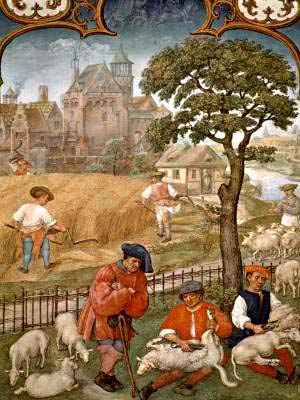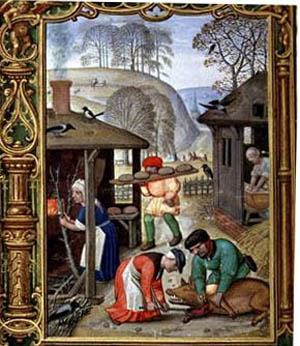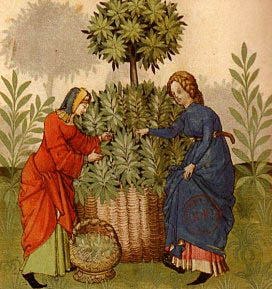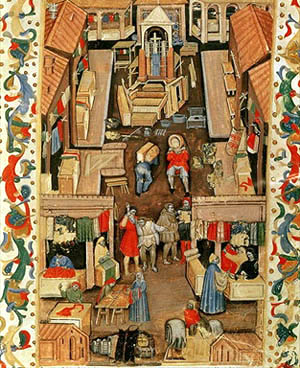 |
World History
The Rich Medieval Menu
Hugh O’Reilly
In addition to bread and wine, there was what was called in southern Catalonia, the compantage, that is, all the other foods. Contrary to widespread opinion, a great deal of meat was eaten and it is obvious from investigations that have been made that the rearing of livestock in France was proportionally greater than in our own days.
There was no farm which did not have its own herd of sheep, particularly as this provided the fields with natural manure, today substituted with artificial fertilizers, resulting in a considerable reduction in the numbers of sheep in France.

There was no farm without its sheep and at least one pig for annual butchering
 |
Pigs, particularly, were very numerous in both town and country. Every family, no matter how poor, reared at least one or two for its own private consumption. The killing of a pig was a classic scene in the calendars of the months sculptured on church doors or painted on manuscripts. For the pig provided meat and a supply of fat for the year. The methods of salting and smoking known in the Middle Ages are still used today.
In addition to meat, there was poultry. Fowls were stuffed, and goose livers and conserves formed part of feast day menus as they do today.
Finally, hunting provided plentiful rewards in the forests, which were larger than now and well stocked with game. There were an infinite number of methods of killing game, ranging from the noose or common snare to specially trained birds of prey, including various traps, pitfalls, nets and devices such as the bow and crossbow. Partridges were caught in bird lime, and stags and wild boars were hunted. Venison was a common item of diet. It was only towards the end of the Middle Ages that the lords tended to reserve their right to hunt on their own estates, like property owners and the State itself do today.
People also fed on dairy produce, and French butter and cheese were already famous. For instance, there were the rich cheeses of Champagne and Brie and angelots from Normandy. In this region, butter was practically the only fat employed for cooking and as the use of all animal fats was forbidden during Lent, the inhabitants obtained special dispensations because it was not possible to procure oil in sufficient quantities.
But this is a peculiar case, for the olive tree had become acclimatized nearly everywhere in France and olive oil was greatly appreciated. Like wine, it was used in the making of several medicinal drinks. Its use alone was authorized on days of abstinence, which were frequent, and the abstinence was severe since it was extended to include eggs also. The eggs that the hens laid during Lent were hard-boiled in order that they should keep, and these eggs were offered for the priest's blessing during the Good Friday ceremonies, which gave rise to the custom of Easter Eggs.
The same requirements of abstinence led the people of the Middle Ages to eat a great deal of fish. Every castle had its breeding ponds attached, and the breeding of perch, tench, gudgeon and eels became a regular source of industry. Ponds were also stocked, as in provinces such as Brienne, and after they were fished, they were re-stocked.

Herbs were used widely to flavor food and for home remedies |
On the coast, sea-fishing was a busy job. Almost everywhere fishermen’s guilds played a great role. On the Mediterranean coast many laws were made for their benefit and to protect their trade against middlemen to assure the actual fishermen to profit from their fish sales. In Marseilles, for instance, middlemen could offer their wares only after midday.
Finally, there were vegetables and legumes, the virtually exclusive diet of monks whose state of life prescribed sobriety and mortification of the flesh. People ate more beans and peas, which took the place of our potatoes.
There were several varieties of cabbage: white and garden cabbages, and cos and round lettuces. The Menágier de Paris speaks of French and Avignon lettuces as being the most popular. Spinach, sorrel, beets, marrows, leeks, turnips and rapes formed part of people’s regular diet.
To these must be added herbs, which were used a great deal, to bring out the flavor of meat and vegetables: parsley, marjoram, savory, basil, fennel and mint – without mentioning the spices that were gradually brought in larger and larger quantities from the Orient, especially pepper. It was so precious it was sometimes regarded as a sort of currency and used by some trading communities to pay their dues, for example, the houses belonging to the Military Orders.

The market of Bologna |
Fruit was very popular: apples and pears, from which cider and perry were already being made. Quinces were considered to have medicinal qualities and used for delicious jams. Cherries, dried prunes, raisin and figs were used in pastes and preserves, a custom that has continued to our own times in certain districts. The peach and apricot, introduced by the Arabs, were already popular at the time of the Crusades.
Long before this time chestnuts were sold in the streets of Paris. Almonds, walnuts and hazelnuts were also greatly enjoyed and used in the making of sweets. And lastly, there were all that the forests could offer: chestnuts, beechnuts, strawberries, raspberries and sloes, all which grew wild and were very well liked.
General diet varied a great deal according to the district, being more dependent then than now on local resources. Nonetheless, exchanges of products were frequent and more widespread than might have been expected, since Maltese figs and Armenian raisins were on sale in Paris. Italian and Provençal traders brought exotic produce to the great fairs of Champagne and Flanders. On a smaller scale, the markets attracted traders from almost every region in France.

Based on Regine Pernoud, The Glory of the Medieval World
London: Dennis Dobson, n.d.,
Posted December 10, 2011

Related Topics of Interest
 Famine, Bread and Wine Famine, Bread and Wine
 Work and Leisure in the Middle Ages Work and Leisure in the Middle Ages
 The Middle Ages - A World of Brilliant Colors The Middle Ages - A World of Brilliant Colors
 Refuting Myths of the Middle Ages Refuting Myths of the Middle Ages
 The Christmas Miracle of the Jewish Boy The Christmas Miracle of the Jewish Boy
 The Middle Ages, a Forest Filled with Symbols The Middle Ages, a Forest Filled with Symbols
 Revival of the Market Revival of the Market

Related Works of Interest
|
|
History | Home | Books | CDs | Search | Contact Us | Donate

© 2002- Tradition in Action, Inc. All Rights Reserved
|
 |
|